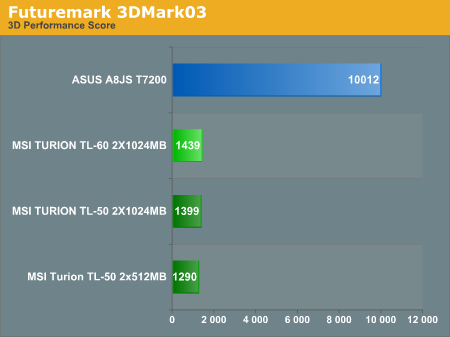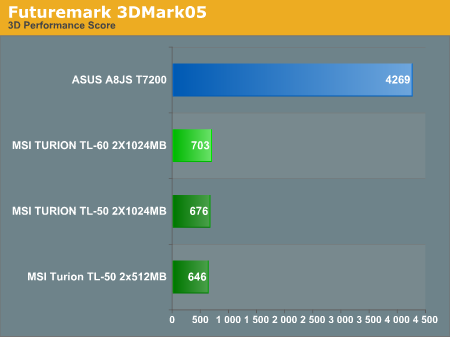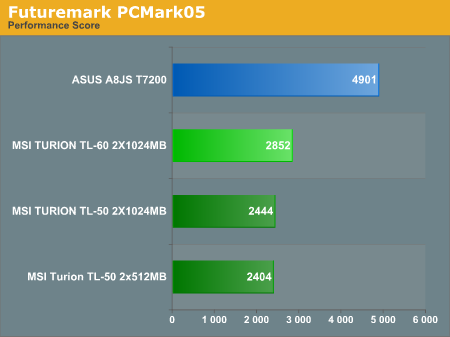MSI Megabook S271: a Look at AMD's Turion X2
by Jarred Walton on October 16, 2006 12:05 AM EST- Posted in
- Laptops
A Quick Look at Gaming/Graphics Performance
One area that we've mentioned a couple times but which we haven't actually addressed yet is the graphics performance of the two systems. We ran 3DMark03 and 3DMark05 on both laptops (3DMark06 requires SM3.0 support and as such was not able to fully run on the MSI notebook). We will also include PCMark05 performance here, simply because it fits in well with the rest of the Futuremark benchmarks. Because we are also interested in looking at how the Core 2 Duo compares to an equivalently clocked Turion X2, we would like to include the CPU results from both 3DMark applications, but the graphics chip has such a large impact on those scores that they are basically meaningless unless you have equivalent GPUs.



In the 3DMark tests, the MSI system's ATI Xpress 1100 IGP simply gets pummeled by the much more powerful GeForce Go 7700. The ASUS laptop is six times faster in 3DMark05 and seven times faster in 3DMark03, and it is also capable of running 3DMark06. PCMark05 also includes some graphics tests as part of the overall benchmark, and that combined with a faster hard drive accounts for the more than 70% performance advantage that the ASUS holds. As the earlier benchmarks showed, the Core 2 Duo T7200 is also faster than the Turion X2 TL-60, but the largest difference we saw earlier was around 40%, with the average performance advantage being closer to 30%.
As a final indication of how inadequate the ATI Xpress 1100 is when it comes to rendering modern 3D graphics, we ran our Half-Life 2: Lost Coast benchmark in both high quality and low quality graphics modes at 800x600 and 1280x800 resolutions. In the high-quality mode, we turned on all of the quality features, set anisotropic filtering to 8xAF, enabled HDR rendering, but left antialiasing disabled. For low quality graphics, we set all of the graphics options to the minimum, and we set the filtering level to trilinear. (We could have dropped it to bilinear filtering, but the performance difference wasn't noteworthy.)
The high-quality graphics mode certainly wasn't going to be playable by any stretch of the imagination, but single digit frame rates even at low resolutions should help give you an idea of how slow the IGP is, and the sad thing is that the Xpress 1100 is almost twice as fast as the Intel GMA950. Dropping to minimum quality graphics, we are still unable to get playable frame rates. 640x480 would be a bit faster, and if we disabled DirectX 9 support Half-Life 2 would probably become playable, at which point you might as well go back and play the original Half-Life -- that can be run on the MSI laptop without any problems.
There are other 3D games available that would actually perform better, but we can say for certain that Quake 4, Doom 3, F.E.A.R., Oblivion, and just about any other 3D game we've used in any recent article would not perform acceptably. Basically, the system provides the bare minimum of 3D graphics support that we would recommend these days and not much else. A lot of people don't need 3D graphics, so that's okay, but there are certainly other options available that include better graphics for a small increase in price. Unlike desktop systems, there's no way to add better graphics to many laptop computers, so just make sure you are absolutely certain you will never need 3D graphics performance (Windows Vista) before you purchase a new laptop that only includes an anemic IGP solution.
One area that we've mentioned a couple times but which we haven't actually addressed yet is the graphics performance of the two systems. We ran 3DMark03 and 3DMark05 on both laptops (3DMark06 requires SM3.0 support and as such was not able to fully run on the MSI notebook). We will also include PCMark05 performance here, simply because it fits in well with the rest of the Futuremark benchmarks. Because we are also interested in looking at how the Core 2 Duo compares to an equivalently clocked Turion X2, we would like to include the CPU results from both 3DMark applications, but the graphics chip has such a large impact on those scores that they are basically meaningless unless you have equivalent GPUs.



In the 3DMark tests, the MSI system's ATI Xpress 1100 IGP simply gets pummeled by the much more powerful GeForce Go 7700. The ASUS laptop is six times faster in 3DMark05 and seven times faster in 3DMark03, and it is also capable of running 3DMark06. PCMark05 also includes some graphics tests as part of the overall benchmark, and that combined with a faster hard drive accounts for the more than 70% performance advantage that the ASUS holds. As the earlier benchmarks showed, the Core 2 Duo T7200 is also faster than the Turion X2 TL-60, but the largest difference we saw earlier was around 40%, with the average performance advantage being closer to 30%.
As a final indication of how inadequate the ATI Xpress 1100 is when it comes to rendering modern 3D graphics, we ran our Half-Life 2: Lost Coast benchmark in both high quality and low quality graphics modes at 800x600 and 1280x800 resolutions. In the high-quality mode, we turned on all of the quality features, set anisotropic filtering to 8xAF, enabled HDR rendering, but left antialiasing disabled. For low quality graphics, we set all of the graphics options to the minimum, and we set the filtering level to trilinear. (We could have dropped it to bilinear filtering, but the performance difference wasn't noteworthy.)
| Half-Life 2: Lost Coast (FPS) | ||||
| Happy Halloween! | 800x600 LQ | 1280x800 LQ | 800x600 HQ | 1280x800 HQ |
| MSI TL-50 2x512MB | 17.49 | 11.79 | 8.57 | 4.34 |
| MSI TL-50 2x1024MB | 18.19 | 12.26 | 8.94 | 4.54 |
| MSI TL-60 2x1024MB | 19.12 | 12.56 | 9.13 | 4.59 |
The high-quality graphics mode certainly wasn't going to be playable by any stretch of the imagination, but single digit frame rates even at low resolutions should help give you an idea of how slow the IGP is, and the sad thing is that the Xpress 1100 is almost twice as fast as the Intel GMA950. Dropping to minimum quality graphics, we are still unable to get playable frame rates. 640x480 would be a bit faster, and if we disabled DirectX 9 support Half-Life 2 would probably become playable, at which point you might as well go back and play the original Half-Life -- that can be run on the MSI laptop without any problems.
There are other 3D games available that would actually perform better, but we can say for certain that Quake 4, Doom 3, F.E.A.R., Oblivion, and just about any other 3D game we've used in any recent article would not perform acceptably. Basically, the system provides the bare minimum of 3D graphics support that we would recommend these days and not much else. A lot of people don't need 3D graphics, so that's okay, but there are certainly other options available that include better graphics for a small increase in price. Unlike desktop systems, there's no way to add better graphics to many laptop computers, so just make sure you are absolutely certain you will never need 3D graphics performance (Windows Vista) before you purchase a new laptop that only includes an anemic IGP solution.










31 Comments
View All Comments
ShapeGSX - Monday, October 16, 2006 - link
The Core 2 Duo mobile processors DO support 64 bit instructions!Core Duo does not.
randomas - Tuesday, October 17, 2006 - link
Doh! I guess I should have checked then, but all the more reason to see them both pull their weight with a real OS!Wesleyrpg - Monday, October 16, 2006 - link
hey all,im eager to see a review of the a8js, thats the laptop that i got my eye on at the moment, if asus play their cards right, the a8js could become one VERY popular laptop.
Any idea on availability though on the A8JS?
piesquared - Monday, October 16, 2006 - link
Good review, but which system was being reviewed, the Asus C2D or the MSI X2?duploxxx - Monday, October 16, 2006 - link
Nice comment, whenever it fits there results, they will publish it.. (does remember me of the time you would test 2P wood-opty in windows, but probably the result was not as expected of your sponsor). Also the memory issues do question your results......the core2duo is for sure the better performing one. Few months ago the X2 versus coreduo was a tight battle, but we all saw the core2duo outperforming the coreduo with glance, so the same thing happens with turion. Intel made his design for laptop and changed it up to desktop and server, AMD did it the other way around.... so for a 3year old design I think it was rather good against all those updating Mobile en core technologies from Intel.
Now from an other perspective. Most of the laptops are supplied with Intel internal graphics. How Will this perform against the ATi Graphics? that would be an interesting review.......
JarredWalton - Monday, October 16, 2006 - link
ATI Xpress 1100 is about twice as fast as GMA950, plus it has full DX9 support (though not SM3.0). Problem is, it's pathetically slow still. I mean, what can you want that the Xpress 1100 can provide but the GMA950 can't? 20 FPS at minimum quality in HL2? If you want 3D performance, I'd say the 7700 in the A8JS is a good starting point. X1400 and GeForce 7400 are both substantially faster than Xpress 1100, buth still pretty sluggish for actual 3D work. X1400 is still okay for video playback and older games (as is 7400), but you can get 7600/7700 for about the same cost I think.JarredWalton - Monday, October 16, 2006 - link
MSI today, ASUS later this week. It's probably already clear which one we preferred, but there's more to say about the ASUS and putting out a 14000 word article seemed like overload.piesquared - Monday, October 16, 2006 - link
Yes, i know, and sorry for the sarcastic question. I guess i'm just wondering why so much content on the Asus solution, when as you say there will be a seperate review later this week. My overall picture of that article was that AMD's solution was a steaming pile of mess not really suitable for anyone. At least that's the impression i(and probably most visitors that read or will read it, so i guess it was successful that way) got, regardless of any conlusion throwing it a bone here and there. What i can't understand is why MSI would even offer up such an abomination for review!! ;)BTW, i did think it was a very good article, aside from the above mentioned slant that seem to ooze from it..
JarredWalton - Monday, October 16, 2006 - link
It's basically a case of getting an okay system, but we would say there are better options out there. If the MSI is cheaper, faster, has more battery life, or some other benefit than other competing laptops, great. It's basically at best equal to other ultraportable options.The ASUS W5F with Core Duo is about as fast (with "slower" integrated graphics, though it doesn't matter much), but it costs more, so there you could say the S271 is "better". Unfortunately, there aren't many faster Turion X2 notebooks around, other than the MSI MS-171772 mentioned in the conclusion.
If all you're after is ultraportables, the MS-1058/S271 is about all I see for Turion X2. It does tend to be about $100-$200 cheaper than any Core 2 equipped ultraportables, or about the same cost as Core Duo equipped ultraportables. In that market, it has a place. I'm not a huge fan of ultraportables, but some people are. I'd personally rather carry an extra 2 pounds and get a 14" (or larger) display.
aidanjm - Monday, October 16, 2006 - link
you rip apart a closed system not designed to be opened up by the consumer, fiddle around inside, then complain when things don't work? even the complaints on memeory compatability seem lame.